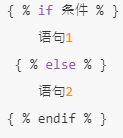创建一个flask实例,使用route构建路由,app.run开启服务
from flask import Flask app = Flask(__name__) @app.route(‘/‘) def hello_world(): return ‘Hello, World!‘
if __name__ == ‘__main__‘:
app.run()
使用装饰器把URL映射到视图函数
@app.route(‘/‘) def index(): return ‘Index Page‘ @app.route(‘/hello‘) def hello(): return ‘Hello, World‘
可以在URL中添加变量,变量会作为关键字参数传递给函数。使用<converter:variable_name>
@app.route(‘/post/<int:post_id>‘) def show_post(post_id): # show the post with the given id, the id is an integer return ‘Post %d‘ % post_id
使用url_for()函数用于构建指定函数的URL。函数名是第一个参数。
没把URL写死在模板中,使用url_for()动态构建的好处:
描述性更好,直观,避免相对路径
from flask import Flask, escape, url_for app = Flask(__name__) @app.route(‘/‘) def index(): return ‘index‘ @app.route(‘/login‘) def login(): return ‘login‘ @app.route(‘/user/<username>‘) def profile(username): return ‘{}\‘s profile‘.format(escape(username)) with app.test_request_context(): print(url_for(‘index‘)) print(url_for(‘login‘)) print(url_for(‘login‘, next=‘/‘)) print(url_for(‘profile‘, username=‘John Doe‘))
利用Jinja2模板引擎,使用render_template()方法渲染模板,只需要提供模板名称和参数变量即可。模板统一放在template文件夹里面。

Jinjia2模板语法:
if语句:

for循环:

注释:

from flask import render_template @app.route(‘/hello/‘) @app.route(‘/hello/<name>‘) def hello(name=None): return render_template(‘hello.html‘, name=name)
客户端网页向服务器传送的数据通过request对象来处理。在视图函数中直接使用可以取到当前本次请求。
通过Method属性可以操作当前请求方法,通过使用form属性处理表单数据,使用file处理文件数据。
@app.route(‘/login‘, methods=[‘POST‘, ‘GET‘]) def login(): error = None if request.method == ‘POST‘: if valid_login(request.form[‘username‘], request.form[‘password‘]): return log_the_user_in(request.form[‘username‘]) else: error = ‘Invalid username/password‘ return render_template(‘login.html‘, error=error)
@app.route("/upload",methods = [‘POST‘, ‘GET‘]) def upload(): if request.method == "POST": f = request.files[‘file‘] basepath = os.path.dirname(__file__) f.save(basepath )
处理文件的时候需要在你的 HTML 表单中设置 enctype="multipart/form-data" 属性。通过files属性访问上传的文件,文件有一个保存的方法即save,可以保存到服务器。
使用redirect()进行重定向
from flask import abort, redirect, url_for @app.route(‘/‘) def index(): return redirect(url_for(‘login‘))
客户端进行操作后,可以使用flash来闪现一个消息。
服务器代码中使用flash("消息“),html中使用get_flashed_messages() 来操作消息
使用Flask_SQLAlchemy进行对数据库的抽象,不用直接写SQL语句,使用python对象来操作数据库。
# 数据库链接地址 app.config[‘SQLALCHEMY_DATABASE_URI‘] = ‘mysql://root:密码@127.0.0.1:3306/test‘ # 动态追踪修改设置,如未设置只会提示警告 app.config[‘SQLALCHEMY_TRACK_MODIFICATIONS‘] = True
create database test charset utf8;
db = SQLAlchemy(app) #定义模型类即数据库的一个表,模型要继承自db.Model class Authors(db.Model): __tablename__ = ‘authors‘ id = db.Column(db.Integer,primary_key=True) name = db.Column(db.String(64),unique=True) #关系,使用relationship描述两个属性的关系 books = db.relationship(‘Books‘,backref = ‘Authors‘) class Books(db.Model): __tablename__ = ‘books‘ id = db.Column(db.Integer, primary_key=True) name = db.Column(db.String(64), unique=True, index=True) author_id = db.Column(db.Integer, db.ForeignKey(‘authors.id‘))
表之间的关系使用realtionship描述,例如上例Authors与Books的关系,realtionship中第一个参数为对应参照的类,
第二个参数backref为反向引用属性。可以使用author.books来调用。
使用Flask-SQLAlchemy时,插入、修改、删除操作,均由数据库会话管理。
会话即db.session。常用的操作如下:
db.session.add(obj) 添加对象
db.session.add_all([obj1,obj2,..]) 添加多个对象
db.session.delete(obj) 删除对象
db.session.commit() 提交会话
db.session.rollback() 回滚
db.session.remove() 移除会话
#添加示例,首先创建所有与db相关联的表
db.create_all() au1 = Authors(name=‘张三‘) au2 = Authors(name=‘李四‘) db.session.add_all([au1, au2]) db.session.commit() bk1 = Books(name=‘linux‘, author_id=au1.id) bk2 = Books(name=‘python‘, author_id=au1.id) db.session.add_all([bk1, bk2]) db.session.commit()


from flask import Flask, render_template, redirect, url_for, flash, request from flask_sqlalchemy import SQLAlchemy from flask_wtf.csrf import CSRFProtect from flask_wtf import FlaskForm from wtforms import StringField,SubmitField from wtforms.validators import DataRequired app = Flask(__name__) app.config[‘SQLALCHEMY_DATABASE_URI‘] = ‘mysql+pymysql://root:878698@localhost:3306/flask_books‘ app.config[‘SQLALCHEMY_TRACK_MODIFICATIONS‘] = False CSRFProtect(app) app.config[‘SECRET_KEY‘] = "jfkdjfkdkjf" db = SQLAlchemy(app) class Authors(db.Model): __tablename__ = ‘authors‘ id = db.Column(db.Integer,primary_key=True) name = db.Column(db.String(64),unique=True) books = db.relationship(‘Books‘,backref = ‘Authors‘) class Books(db.Model): __tablename__ = ‘books‘ id = db.Column(db.Integer, primary_key=True) name = db.Column(db.String(64), unique=True, index=True) author_id = db.Column(db.Integer, db.ForeignKey(‘authors.id‘)) class Authorform(FlaskForm): author = StringField(‘作者‘,validators = [DataRequired()]) book = StringField(‘书名‘,validators = [DataRequired()]) submit = SubmitField(‘提交‘) @app.route(‘/‘) def view(): authors = Authors.query.all() author_form = Authorform() return render_template(‘index.html‘,authors=authors,form = author_form) @app.route(‘/add_book‘,methods=[‘POST‘]) def add_book(): author_form = Authorform() author_name = author_form.author.data book_name = author_form.book.data # 校验参数 if not all([author_name,book_name]): return "作者或者书籍为空" author = Authors.query.filter_by(name = author_name).first() if author: book = Books.query.filter_by(name = book_name).first() if book: flash("已存在该书籍") else: bk = Books(name = book_name,author_id=author.id) db.session.add(bk) db.session.commit() else: at = Authors(name = author_name) db.session.add(at) db.session.commit() bk = Books(name=book_name, author_id=at.id) db.session.add(bk) db.session.commit() return redirect(url_for(‘view‘)) @app.route(‘/delete_book/<int:book_id>‘) def delete_book(book_id): book = Books.query.get(book_id) db.session.delete(book) db.session.commit() return redirect(url_for(‘view‘)) @app.route(‘/delete_author/<int:author_id>‘) def delete_author(author_id): author = Authors.query.get(author_id) for bk in author.books: db.session.delete(bk) db.session.delete(author) db.session.commit() return redirect(url_for(‘view‘)) db.drop_all() db.create_all() au1 = Authors(name=‘李**‘) au2 = Authors(name=‘张**‘) db.session.add_all([au1, au2]) db.session.commit() bk1 = Books(name=‘linux‘, author_id=au1.id) bk2 = Books(name=‘python‘, author_id=au1.id) bk3 = Books(name=‘c++‘, author_id=au2.id) db.session.add_all([bk1, bk2, bk3]) db.session.commit() if __name__ == ‘__main__‘: app.run(debug=True)
<!DOCTYPE html> <html lang="en"> <head> <meta charset="UTF-8"> <title>book</title> </head> <body> <h2>添加</h2> <form action=‘/add_book‘ method="post"> {{ form.csrf_token() }} {{ form.author.label }}{{ form.author }}<br> {{ form.book.label }}{{ form.book }}<br> {{ form.submit }}<br> {% for message in get_flashed_messages() %} <span style="color: red">{{ message }}</span> {% endfor %} </form> <h2>书籍展示</h2> <ul> {% for author in authors %} <li>作者:{{ author.name }}<a href="{{ url_for(‘delete_author‘,author_id=author.id) }}">删除</a></li><br> <ul> {% for book in author.books %} <li>书名:{{ book.name }} <a href="{{ url_for(‘delete_book‘,book_id=book.id) }}">删除</a></li><br> {% endfor %} </ul> {% endfor %} </ul> </body> </html>
from flask import Flask, request from werkzeug.utils import secure_filename import uuid from PIL import Image import os import torch from torchvision.models import resnet18 from torchvision.transforms import ToTensor app = Flask(__name__) net = resnet18(pretrained=True) net.eval() @app.route("/",methods=["GET"]) def show(): return "classifier api" @app.route("/run",methods = ["GET","POST"]) def run(): file = request.files[‘file‘] base_path = os.path.dirname(__file__) if not os.path.exists(os.path.join(base_path, "temp")): os.makedirs(os.path.join(base_path, "temp")) file_name = uuid.uuid4().hex upload_path = os.path.join(base_path, "temp", file_name) file.save(upload_path) img = Image.open(upload_path) img_tensor = ToTensor()(img).unsqueeze(0) out = net(img_tensor) print(‘out_shape‘,out.shape) pred = torch.argmax(out,dim = 1) print(pred) return "result_cls : {}".format(pred) if __name__ == "__main__": app.run(host="0.0.0.0",port=5555,debug=True)
from flask import request, Flask import base64 import cv2 import numpy as np app = Flask(__name__) @app.route("/", methods=[‘POST‘,‘GET‘]) def get_frame(): # base64编码转为图片并保存 # 传输的base64编码为转换后整个值中data:image/jpg;base64,后的值 img = base64.b64decode(str(request.form[‘image‘]).split(‘base64,‘)[-1]) image_data = np.fromstring(img, np.uint8) image_data = cv2.imdecode(image_data, cv2.IMREAD_COLOR) cv2.imwrite(‘base64_2_img_01.png‘, image_data) print(image_data) return ‘koukou‘ if __name__ == "__main__": app.run("0.0.0.0", port=5005)
from flask import Flask, render_template, request, redirect, url_for, make_response, jsonify from werkzeug.utils import secure_filename import os,time from datetime import timedelta from main_demo import detect_cv2 ALLOWED_EXTENSIONS = set(["png","jpg","JPG","PNG", "bmp"]) def is_allowed_file(filename): return ‘.‘ in filename and filename.rsplit(‘.‘, 1)[1] in ALLOWED_EXTENSIONS app = Flask(__name__) # 静态文件缓存过期时间 app.send_file_max_age_default = timedelta(seconds=1) @app.route("/upload",methods = [‘POST‘, ‘GET‘]) def upload(): if request.method == "POST": f = request.files[‘file‘] if not ( f and is_allowed_file(f.filename)): return jsonify({ "error":1001, "msg":"请检查上传的图片类型,仅限于png、PNG、jpg、JPG、bmp" }) basepath = os.path.dirname(__file__) upload_path = os.path.join(basepath, "static/images",secure_filename(f.filename)) f.save(upload_path) #config cfg_file = ‘pytorch-YOLOv4-master/cfg/yolov4.cfg‘ weightfile = ‘pytorch-YOLOv4-master/checkpoints/yolov4.pth‘ imgfile = upload_path detected_path = os.path.join(basepath, "static/images", "output" + secure_filename(f.filename)) #run & save detect_cv2(cfg_file, weightfile, imgfile, detected_path) # run(upload_path, conf, detected_path) # return render_template("upload_ok.html", userinput = user_input, val1=time.time(), path = detected_path) path = "./images/" + "output" + secure_filename(f.filename) return render_template("upload_ok.html", path = path, val1 = time.time()) return render_template("upload.html") if __name__ == "__main__": app.run(host=‘0.0.0.0‘, port=5555, debug=True)
<!DOCTYPE html>
<html lang="en">
<head>
<meta charset="UTF-8">
<title>Flask上传图片演示</title>
</head>
<body>
<h1>使用Flask上传本地图片</h1>
<form action="" enctype=‘multipart/form-data‘ method=‘POST‘>
<input type="file" name="file" style="margin-top:20px;"/>
<br>
<input type="submit" value="上传" class="button-new" style="margin-top:15px;"/>
</form>
</body>
</html>
<!DOCTYPE html> <html lang="en"> <head> <meta charset="UTF-8"> <title>Flask上传图片演示</title> </head> <body> <h1>使用Flask上传本地图片</h1> <form action="" enctype=‘multipart/form-data‘ method=‘POST‘> <input type="file" name="file" style="margin-top:20px;"/> <br> <input type="submit" value="上传" class="button-new" style="margin-top:15px;"/> </form> <img src="{{ url_for(‘static‘, filename= path,_t=val1) }}" width="400" height="400" alt="图片识别失败"/> </body> </html>
原文:https://www.cnblogs.com/ywheunji/p/14309360.html